British developer Magmatic Games', Travel Town, has already shown it is capable of bringing in some impressive numbers with its merge adventure gameplay where players can discover and work their way through hundreds of levels.
But what has made this merge game stand out from the competition? In this guest post Belka Games lead game designer (RnD) Olga Semykina looks under the hood of Travel Town to deconstruct the game and its inner workings.
What makes Travel Town interesting?
Travel Town is an up-and-coming merge-2 project from a British developer called Magmatic Games. The game started buying traffic in early 2022 and has been making steady progress ever since. An especially impressive performance surge came in early 2023: downloads increased by more than two times, and revenue almost tripled. If the trend was anything to go by, this is just the beginning.
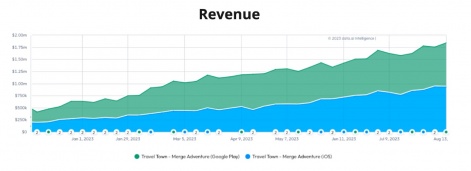

The company initially prioritised Android because it's easier to launch a project marketing-wise. But as of today, the downloads and revenue are distributed almost equally between iOS and Android. That's a typical pattern in the industry. For instance, Love & Pies' sales are split between the platforms 50/50, while Merge Mansion and Gossip Harbor net more revenue from iOS.
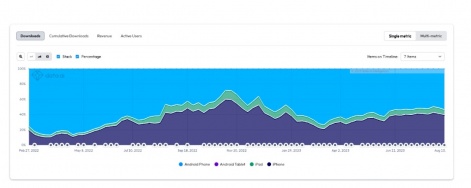
Travel Town's primary audience is located in the US. That's an important metric because the US generates more than 50% of the game's revenue. Other major sources of revenue include South Korea, Japan and Europe.
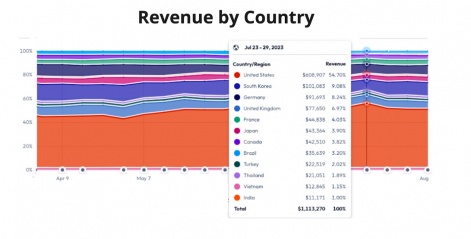
And it's only natural that Japan is on the list because merge games are taking the Japanese market by storm. If we look at Merge Mansion, almost 20% of its revenue comes from Japan.
Here are some of Travel Town's main competitors:
- Merge Mansion
- Gossip Harbor
- Love & Pies
As you can see below, Travel Town has racked up the most downloads, but Merge Mansion still takes up the top spot regarding revenue, with Travel Town placing second.
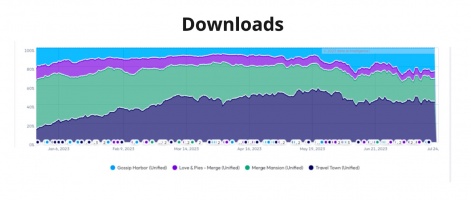

Merge Mansion was the first to rise to the top of the merge-2 market, and it's been holding its ground ever since. Merge Mansion's competition surpasses it UI/UX-wise, and the game has a pretty niche setting, but the team developed a solid marketing strategy. Meanwhile, Gossip Harbor and Love & Pies are similar to each other in their setting, visuals, events and offers.
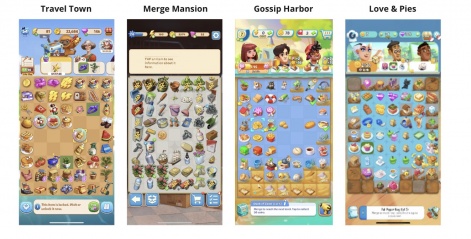
But let's take a closer look at Travel Town now. What makes it stand out from among its competitors?
Core and meta game loops
The game's core is standard merge-2 gameplay. Players complete the characters' orders by merging items, earning resources, and using them to construct buildings in the city. An unobtrusive dialogue-based narration accompanies the whole process.
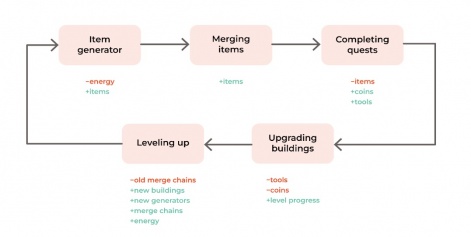
Classic, right? But here's when it gets interesting. You need several types of resources to construct buildings - some of the stages (about one in three) require Tools in addition to the obligatory coins.
Part of the orders help you earn coins, but some come with Toolboxes as a reward. This adds an extra meta game mechanic and lets players develop various strategies by prioritising some orders over others.
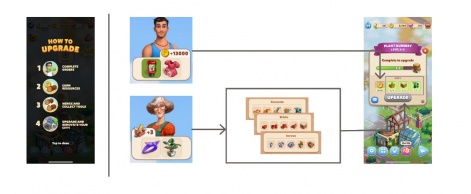
Merge chains
Travel Town implements various merge chains, some of which are unique to the game. New merge chains are added as players complete more levels and construct new buildings. Travel Town's competitors mostly use similar merge chains with varying lengths, but Travel Town likes to change things up. Here are some of the chains available in the game:
- Nestled chains - you create a new generator in the first part of the chain before you can move on.
- Combined chains - you need to merge items from the two other chains together to get the final item.
- No-energy generators - they can spawn items in free adjacent cells after a cooldown (for fairness' sake, Love & Pies also has these).
- Charging generator - it needs five taps to "charge up" before it spawns items, and it can even spawn a "defective" one.

This sort of diversity keeps players engaged and helps balance order difficulty. Short chains bring the players satisfaction for reaching a milestone, and long ones make the reward you get after making a complex item feel like it was worth the effort.
But there's still room for growth - like working on the UX to help players better understand the unusual merge chains. Those bring about a lot of questions in the closed fan community, even among the experienced players.
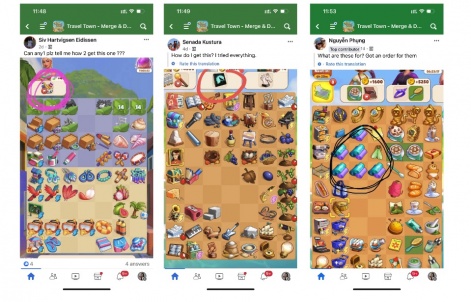
Balancing orders
Merge games have one of the best retention and engagement rates at lower levels, but both values drop over time. It takes a week with some games and a month with the others. The problem lies within the complex, drawn-out orders that players face as they progress, which require merging high-tier items. Those stall the game because you must keep grinding for days to complete a single quest. And that affects the dynamics. Players realise immediately that they won't make it far during the game session, which saps their motivation. Many people either stop playing entirely at this point or stop making in-game purchases.
Gossip Harbor has a similar problem, as does Love & Pies to a lesser extent. At higher levels, players get just one or two quests, which can be difficult. Travel Town and Merge Mansion both try to solve this issue by balancing orders.
This is how they do it:
- Players always have four orders - three with coin rewards and one with Toolboxes.
- Varying order difficulty helps the game keep its momentum and lets players develop their own strategies.
- There's one difficult order with a big reward.
- One really easy one that takes less than one session to complete.
- Two medium-difficulty ones.
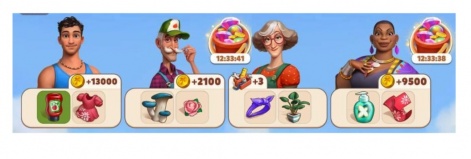
Monetisation
This game is monetised through in-app purchases and ads, focusing on IAP.
The only thing players can buy in the in-game store are Diamonds but offers also let them buy energy. Diamonds can be used to purchase various items, energy, time boosts and more. Here are some lots that stand out:
- Wild Pearl - can be merged with any item.
- Scissors - split an item into two lower-level ones.
- Chests - containing Diamonds, energy, coins, and tools for the meta loop. Players can never tell how many resources they're going to get, so it's a popular and exciting gacha-type feature.
Special offers
While Travel Town isn't overflowing with offers, it doesn't stop the game from making money and even pulling ahead of its competitors.
The game has two types of recurring promos:
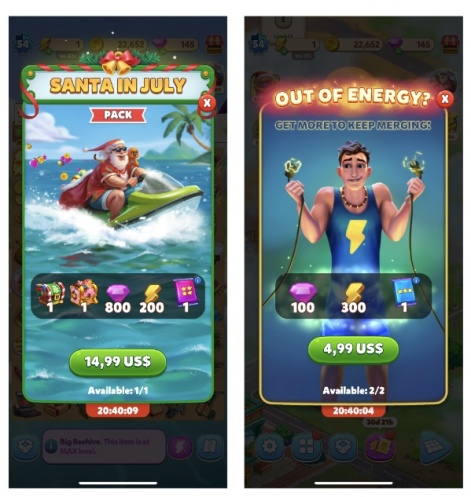
LiveOps Offers are launched daily and change once every 24 hours. Besides Diamonds and energy, they usually contain items that are almost impossible to buy otherwise, like chests (usually with Diamonds and energy), Wild Pearls and Scissors.
Out of Energy Offers are displayed every time players with low energy tap out of the pop-up message offering them to buy more energy with Diamonds. You can purchase Diamonds, energy and item packs that way.
What's noteworthy is the price setting. Out of Energy Offers usually don't make the player step out of their comfort zone and are set at their average purchase value. LiveOps Offers, on the other hand, are meant to stimulate players, and the price is always above APV. So even with just those two types of offers, the developers let players choose between small impulse buys and more expensive purchases that include unique items in addition to the standard currencies.
The same types of offers pop up when there's an event with a unique playing board and its own Energy going on. The price setting and rewards are the same with the exception of energy - that resource is event-specific.
It seems like Travel Town would be a good fit for other types of offers, too. Here are some that the other merge-2 games use the most:
- Two or three special reward bundles for the store.
- Endless Offer, Piggy Bank, Battle Pass.
Ads
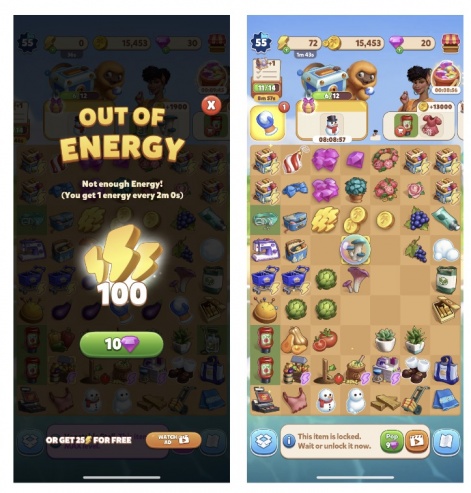
The game shows rewarded ads both to non-paying players and whales, but there's a limit:
- Four ads a day worth 25 energy each (100 energy in total).
- You can buy items right on the merge board, and the exchange rate can be quite lucrative compared to the Gem purchases. These integrated sales points usually perform well because the offers are of high value to the players.
Power boost
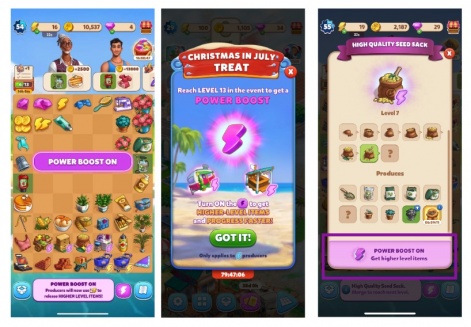
Travel Town has an untypical merge-2 game Power Boost that speeds up your progress.
Players can activate a Boost x2, which will make them spend two energy instead of one when they generate items, but at the same time, the spawned items will be level two from the get-go.
This Power Boost is used extensively by Coin Master, MonopolyGO, and other competitors. When players deactivate Boost x2, they feel like they're progressing too slowly in comparison. It makes them want to activate Boost x2 again, even though it expends more energy.
This is also a good way to engage whales. Say, the most expensive $120 pack from the store gets the player 8,000 Diamonds. Even at a low exchange rate of 100 energy per 40 Diamonds, that's 20,000 energy. The player should have the opportunity to spend it fast and without any extra hassle.
Main features and LiveOps
Travel Town focuses on increasing player activity to monetise the game. To achieve that, the developers use various game mechanics and other methods to motivate and put pressure on players. They can be divided into those that affect player activity short-, mid-, and long-term.
Short-term effects
Travel Town puts a lot of effort into increasing short-term player engagement. The game implements various time-pressure mechanics like limited-time quests and boosters. That motivates players to prolong their game sessions and be more active to get the most out of those boosters.
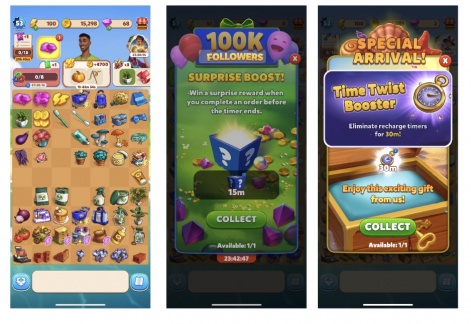
- An extra limited-time order that lets the player earn an additional reward, as well as energy or Diamonds, if it's completed in time.
- A limited-time gift box gets added to one of the orders. If the player manages to complete it in time, they get a gift box alongside the regular reward, and one more gift box appears in another active order. The time limit is set to 15 minutes. It can be a standalone event, but sometimes you get gift boxes as a reward in other events.
- A temporary generator booster that lets you skip generator cooldowns.
Limited-time gift boxes are noteworthy because they prolong game sessions and increase monetisation at the same time. To make the most of a gift box, players must complete as many orders as possible in 15 minutes. And Travel Town has another well-implemented game-of-chance here - the gift can contain any amount of energy from 10 to 200.
Outside of events, there's one more recurring feature that sets the pace of player activity every day. It's the Daily Challenge.
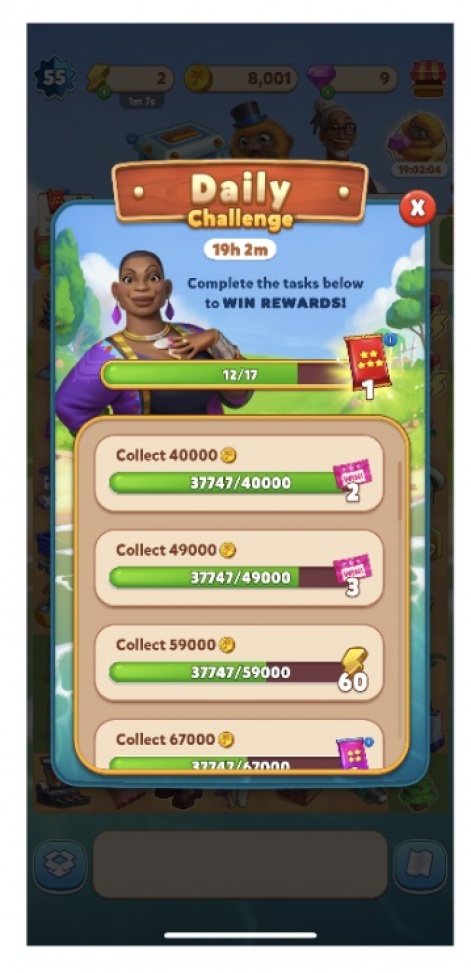
The Daily Challenge quests have several goals: collecting coins (the main objective), merging items, and spending Diamonds.
Players get a reward after completing each quest and an extra one for finishing all of them.
The quests progress simultaneously. The game is balanced in a way that has the next quest 60-90% complete by the time you're done with the current one. This always makes players feel like they need to do "just a little bit more" to complete the next quest.
More than half of the quests get done as players go about their usual gameplay, with no extra effort required, but to complete the remaining 20-40%, they'll have to either be more active and/or pay money.
Quest difficulty scales depending on player activity - more active players get harder quests. The number of quests also changes. It can be anything from nine to 35 a day.
Mid-term effects
The next LiveOps category focuses on increasing mid-term engagement. All of these events alternate and go on for three to four days.
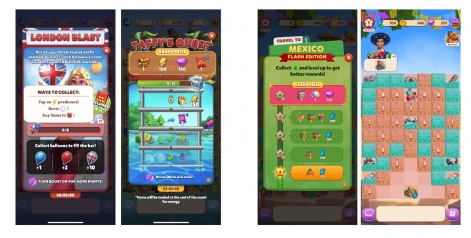
- Milestone events (a lot of other merge-2 games use these, too): Such events have a long progress bar divided into milestones. You get rewards for reaching every milestone and a Grand Prize at the end. The bar fills up as you generate resources. The milestones act as additional micro goals, and event paywalls help with conversion.
- Special merge boards (also used in Merge Mansion): Players get a separate, event-specific merge board with its own merge chains, levels, Energy, and special offers. This lets them spend more money and time in the game while the new milestones and the added time pressure eggs them on.
- Decorations (also used in Gossip Harbor): On top of the usual order rewards, players get some currency they can spend on decorations for a certain location on the map. There are also additional milestone rewards.
Long-term effects
Besides the ongoing event rotation, the game uses albums to increase long-term engagement. It's meant to boost both gaming and payment activity.
The album mechanic here is the same as in many other games. There are 12 albums with nine cards in each one. You get cards from card packs that drop either during gameplay or with any purchase worth more than $5 (so it encourages the player to spend more). The rarest packs make for a good incentive to spend money on expensive bundles and event paywalls. To generate additional activity spikes, Travel Town often launches events that have more card packs among the rewards or just some of the rare ones. With the right balance, and if you control picture drop rates right, these packs can be a great reward from the in-game economy standpoint. On the one hand, the player gets their satisfaction, but on the other, they don't actually receive any game-breaking currencies.
Growth opportunities
All current Travel Town features are focused on individual player goals. There are no social or competitive mechanics at all. On the one hand, they're not as common in merge games. On the other hand, if you look at the top 100 casual games, competitive mechanics are the most popular. They come in all shapes and forms - limited-time tournaments, various races, 1-on-1 competitions, etc. My prediction is that competitive mechanics will be the next big thing in merge games, too. Gossip Harbor, with its tournaments, has already made the first step in that direction.
In conclusion
Travel Town is a good example of a game that combines short-, mid-, and long-term effect features and events:
- Minimal daily activity and time pressure for its short-term goals.
- Boosting core gameplay and adding another layer of mechanics for the mid-term ones.
- Global quests and gacha mechanics that reinforce long-term engagement.
Edited by Paige Cook






















